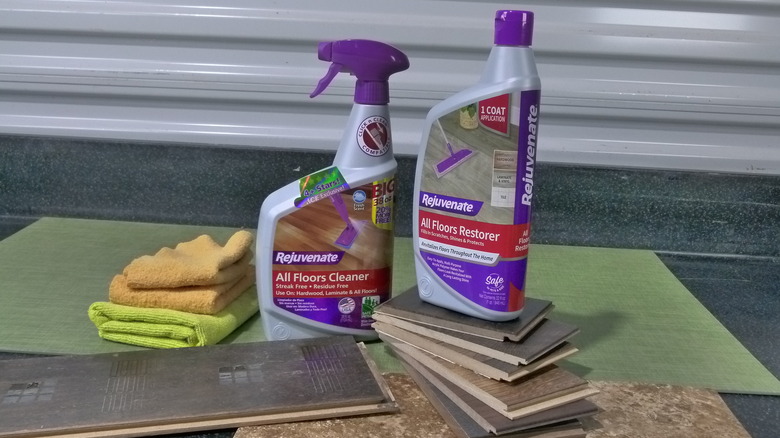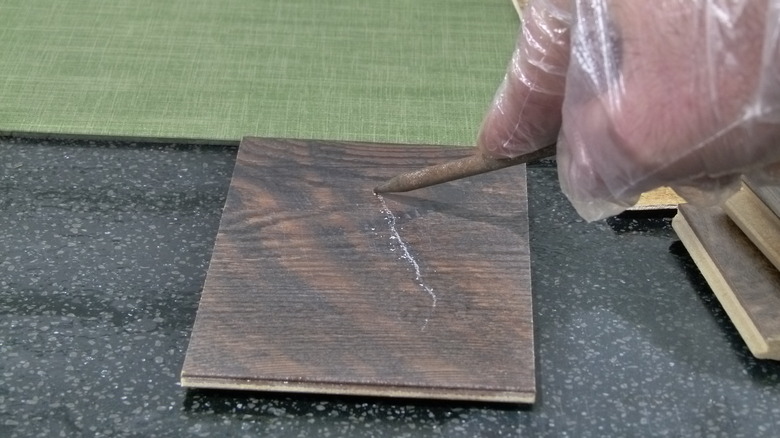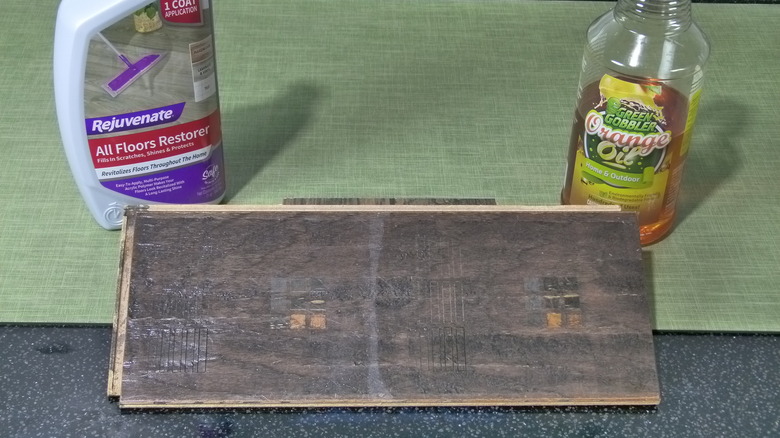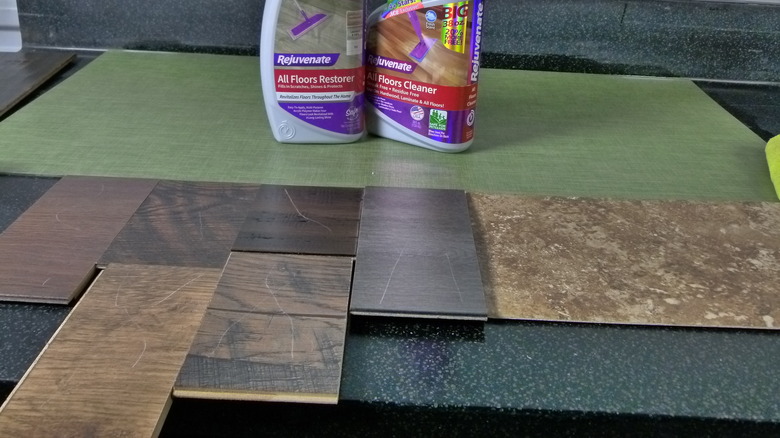We Scratched The Surface Of Using Rejuvenate All Floors Restorer With Shining Results
The Rejuvenate family of floor care products has been enjoying some attention on social media lately so we started paying attention. The claims seem entirely reasonable; no miracles, only a dramatic shine, some improvement to scratches, and durability. TikTok user @pcosnowmama reports that the All Floors Restorer, $21.99 at Ace Hardware, "stood the biggest test of time — 2 babies and a dog." And, @jessmapes on TikTok was impressed that it could revive even her "cheap old laminate." The positive reviews keep pouring in, but they had us at "and a dog."
Our next move was to figure out why the product works — or appears to. (Is there a difference when it comes to floor restorers?) We are none of us professional chemists, materials engineers, or even amateur or aspiring chemists or engineers for that matter. So, it is a labor of love to wade through the usual slurry of solvents and chemical catalogs that explain one inscrutable set of terms after another.
What we learned is that Rejuvenate All Floors Restorer is — drum roll — wax. Before you roll your eyes and mutter, "Another floor wax," there is a bit of a difference here in that Rejuvenate employs oxidized polyethylene (PE) among other ingredients. PE is found in all manner of products, including floor waxes and food coatings, and it has properties you want like scratch resistance and gloss. It's also a tackifier, not in the overdone silver and gold decor sense, but in that it makes you less likely to slip and fall.
Setting up for our tests
We took our investigation to the lab. The lab is not a retriever (we have Great Pyrenees), and it's also not a lab, but the workshop where we test products, build things, and build things for testing products. Some digging around turned up two Allen + Roth laminate samples, two Pergo laminate samples, Style Selections laminate and engineered hardwood samples, and a few miscellaneous LVP and Parterre Tela vinyl tile remnants. To this, we added an actual plank of the engineered flooring from our entryway that has seen some abuse and which we're in the process of replacing. The plan was straightforward — abuse these bits of flooring and see if Rejuvenate All Floors restored them to their former glory (of 25 minutes earlier).
The bit of recovered engineered hardwood that had seen actual duty got a special job; more on that later. The flooring samples — those little blocks given away in home centers and which even children can't think of a larcenous use for — represented a wide range of costs and, presumably, quality. The vinyl had never been installed, though one sample had been trodden upon for a few weeks in a trial run. All of these would be scratched up with sandpaper and a scratch awl. (This is, incidentally, the first time in many years we've come up with a reason to actually scratch something with a scratch awl, which is a poor substitute for a pencil in every regard except scratching.)
Restoring a floor that's scratched awl up
It turns out that the laminate and engineered hardwood samples, having never known the gentle caress of feral children and Great Pyrenees, are rather hard to make an impression on. Like, literally. After an initial cleaning as required by the Rejuvenate system, we took several aggressive swipes at each block with 80-grit sandpaper, producing a satisfying swath of scratches that mostly disappeared with the follow-up cleaning. These floors have a protective coating, usually polyurethane, that recovers well from scratches. (It would be a rather counterproductive protective coating, otherwise.) No matter; the scratch awl did its work in only a moment, making deep marks in the wear layer of actual wood. We cleaned the wood and vinyl again and applied the Rejuvenate All Floors Restorer with a microfiber cloth, following the package directions.
We etched and engraved the face of the recovered engineered hardwood boards with two of what are known (at least to us) as "material test arrays" using the xTool S1 40W laser engraver and cutter, which we recently tried and were impressed by. This imparts a pattern of shapes at various depths. After cleaning, we treated one pattern with the Rejuvenate product and one with straight Green Gobbler orange oil. Our intent was to find the exact point at which the product became ineffective — and boy did we.
Review-enating All Floors Restorer
Basically, neither product was effective at filling scratches in the recovered flooring. The lightest etchings would disappear in the right light if you very carefully looked at something else in the room, perhaps a Great Pyrenees. But the majority of the marks were simply unaffected by Rejuvenate All Floors Restorer. The orange oil darkened the plywood beneath the wear layer a bit more than Rejuvenate did, but this is probably an accident of its color. All of the other pieces we tested produced nearly identical results. Rejuvenate All Floors managed to finish erasing the sandpaper scratches that were mostly already eliminated by cleaning and had very little effect on the deeper awl scratches. But, keep in mind that there are better, inexpensive ways to fix large flooring scratches than with floor wax.
Rejuvenate All Floors Restorer did make the flooring shiny, even after multiple cleanings (with the approved All Floors Cleaner, available at Ace Hardware for $8.59). The side of the recovered engineered hardwood treated with Rejuvenate was noticeably shinier than the side treated with orange oil. We repeated this whole process in a bathroom that has so far escaped the flooring redo, and the gloss was even more remarkable over a larger area. Based on our tests and what we learned, Rejuvenate All Floors Restorer is probably a reasonable choice if your floors have only light wear and if you are mostly concerned with a high shine. With proper care, it promises to be fairly durable, scratch-resistant, and even tacky.



